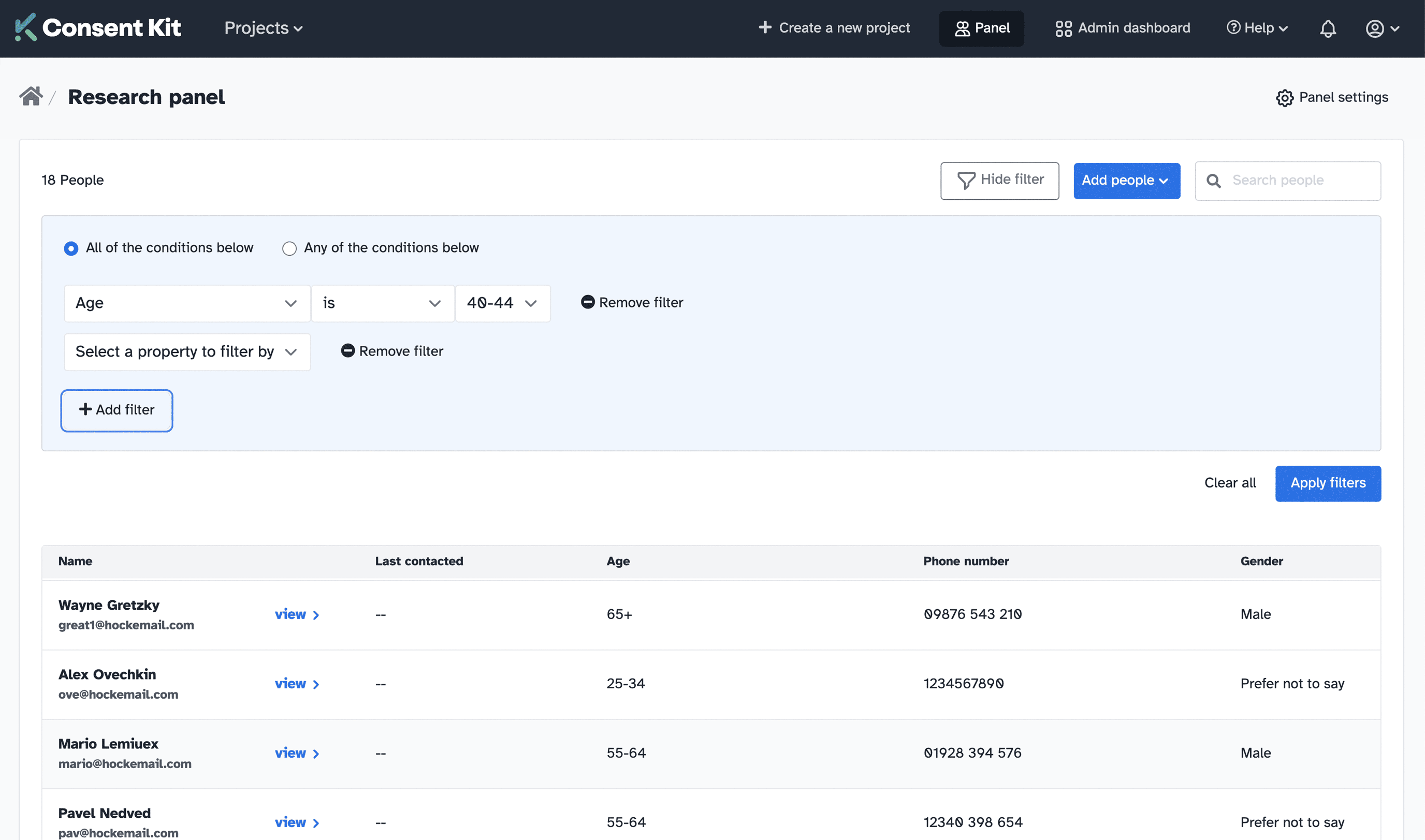Research Recruitment & Research Ops
How to Recruit Research Participants by Email: The Complete Guide

Written by: Phil Hesketh
Published on:
Are you planning to recruit user research participants by email? Looking for advice on how to write a perfect recruitment email for a research study?
You know - I can’t even begin to estimate how many “open or delete” decisions I make in a day. And I’m betting your user research participants are no different.
If you’re recruiting participants via email, you need to be highly strategic about what you send them.
In this article, you'll learn how to write a recruiting email for research and recruit research participants by email.

How to recruit user research participants by email
If you’ve run previous studies, have a plentiful user database, or use a research CRM in your organization, you’ve got everything you need to start sending research recruitment emails.
Many researchers overlook their existing database of potential participants, but it’s often the simplest and easiest avenue to get your research underway on time and on budget. It also means that these people have willingly given you their email address at some point—so you can step into their inbox with confidence and consent.
The huge upside to contacting people who are already in your database is that they know and trust you, and they understand what your organization and product do. This increases the likelihood of them opening emails from you and opting into your studies.
When corresponding with users via email, I draw upon my foundational experiences in customer service, which, in many aspects, mirror the principles of User Experience Research (UXR).
Remind the user that you are not spam and place it in the header of the email or as close to the start of the email. Remind the user of the communication before this email, what was it, and how we connected.
What is the incentive for the user to communicate? Bring that up soon, it’s a buy-in if you have gift cards. Flattery will move mountains for users, reminding them that their input/ insights are valuable and they are contributing to a worthwhile task/ project.
Make the email message concise. Long emails are not read, frustrating for the educator in me, but most readers skim over reading materials. Let the users know the forms of contact ( email, chat/server, video meeting) and when the follow-up will occur.
Prep the user if using a video platform and if the user has access to it. Some users will not have Zoom loaded or would rather communicate over the phone so learning this is essential in gathering prepared users. Remind the users of the requirements and the time needed ie., if you are watching them complete a task, the app must be accessible.
Emily Dobson, UX Researcher
Creating an internal hub of potential participants that you can segment and contact can be a huge advantage for future research outreach if you don’t have one set up already.

If you don’t have any sort of database to draw from, you might try reaching out to relevant organizations such as business partners, universities, community organizations or non-profits, to ask if you can either have access to their list for a specific research study, or if you can include information about your study in their regular newsletter.
You could also strategically find potential participants through social media, forums, community groups, and industry groups, and then send outreach emails to encourage people to participate in your studies.
However — cold emails like this can put your organization at risk of non-compliance with data privacy regulations.
I advise people to stay away from cold emailing because of GDPR compliance. Every person you email should have given their explicit consent or opted in for this type of communication.
Julian Della Mattia, ReOps Specialist, the 180
Read more: A 10 Step Framework For Recruiting Participants For Research
How email recruitment works in user research?
Once you’ve got your database of participants ready, you’ll need to work the email recruitment process into your overall UX research plan.
You’ll need to think about:
Who to contact - the whole list, or specific segments/demographics?
How you’ll create a diverse participant pool
How you’ll manage informed consent
Developing a screener survey
How many people you’ll need to recruit
How to ensure you get enough responses
In terms of the cadence of sending participant recruitment emails, numbers vary according to each project and each context.
If your response rate is usually high, you send in small batches until you cover the number of participants you need. For example, if you need 10 participants you might send batches of 150 and space them out a bit, at say 4-5 days, until you’ve met your participant criteria.
Julian Della Mattia, ReOps Specialist, the 180
Read more: Top 4 UX Research Challenges in 2023
How to write a research recruitment email?
An email to recruit research participants can be broken down into different components, with each part having its own role to play in getting an email opened, read, and replied to.
Developing customizable email templates for different types of research projects can help you speed up the process for future initiatives, and you can optimize these templates over time to increase your response rates.
Create your own reusable email templates with Consent Kit
Try free for 14 daysA few of my best tips for researchers to get better response rates from their recruitment emails are to:
Put the incentive amount in the subject line.
Keep it casual - if you can.
Make it clear that a real human is writing the email, and is eager to talk to you.
Stress that customer feedback has a real impact on company decisions (if it does!).
Make it easy for the user to schedule with you (e.g. “click here to book a time”)
Megan Scheminske, Senior UX Researcher, Teachable
Personalize your outreach
Nobody likes to feel like they’re part of a faceless, spammy outreach campaign. Try testing personalized subject lines, intros, and body copy to see if this increases your response rates.
Your email should be as relevant to each individual as possible, but this will be dependent on whether you send emails to only 10 people, or to 10,000 people.
Sender name
Humanizing your “from” name creates an instant connection with a reader, as opposed to sending from a generic team name or company address. Your safest bet is to include the sender’s name as well as your organization name for maximum engagement.
Subject line
Your subject lines can make or break your open rates for recruitment emails, so you’ll need to make them:
Eye-catching enough to stand out in a perpetually crowded inbox
Inviting enough to encourage a click
Clear enough to be easily understood
Specific enough for participants to know what’s inside
No pressure!
Hubspot research showed that the most effective email subject lines engage curiosity, include promotional offers, and are personalized to each recipient’s interests. Think about how you could weave these aspects into your subject text.
Don’t overlook writing some catchy preview text either. This valuable piece of real estate is often overlooked by researchers, but it gives you an extra chance to get your participants’ attention and encourage them to open your email.
Body copy
When a participant opens your email, you only have a few seconds to get their attention. Don’t write a long fluffy intro or risk confusing the reader with a bunch of unnecessary details—just get straight to the point of your outreach.
I recommend sticking to the “bottom line up front” (BLUF) approach. This is where you make the point of the email known in the first sentence or two.
You want to quickly and clearly establish your legitimacy, state your ask, and state the benefit of participating. You can supplement your “BLUF” with more information in the email. It’s the same approach I use for recruiting live on the field and it works (on top of social cues)
Brenda Hoyle, Senior UX Researcher & Strategist
The BLUF method ensures that your reader understands all the important things they need to know about your study while you have their full attention.
You should include details about:
Who is eligible to participate
Why they should participate
How research will be conducted (e.g. user interviews, user testing, focus group)
Where and when research sessions will take place
Who will be attending the session
How long the research will take
Whether there is an incentive offered
Contact information
We recommend keeping your email short, as brief emails tend to be more effective than writing a novel about your research study.
But if your research initiative requires a more in-depth explanation, try listing the key information in bullet points underneath the BLUF section so participants can quickly skim and get the extra details.
Here’s an example of a short email
Hi Tim,
My name is Maggie from StripeBox. I’m conducting a research study for our new product, and I’d love it if you could help us out.
Participation will take about 15 minutes of your time and will involve you answering 5 quick questions after looking at a website page. You’ll receive a $100 Amazon voucher for your feedback.
If you’re interested in helping us out with our study please click this link for more information, or you can reply to this email with any questions.
Thanks! Maggie Smith, Senior UX Researcher StripeBox
And here’s a longer example
Hi Tim,
Our team at StripeBox has been working on upgrading our product dashboard, and we’d love your help as you’re one of our power users.
We’re running a research study to see how people interact with our new dashboard layout. We’ll give you a link to the page and 5 quick questions to answer. This will take around 15 minutes of your time.
Would you like to help us out? If so, click this link to get all the details.
Why you should participate:
You’ll get a $100 Amazon voucher (woohoo!)
You’ll get advance access to the upgraded dashboard
You’ll be helping us create a better product that can save you even more time and money each week
Got questions? You can either click this link or reply directly to this email.
Thanks! Maggie Smith, Senior UX Researcher StripeBox
Note: Your email copy should be consistent with your company’s tone and style. If you have a fun, upbeat brand voice, don’t make your email sound all stiff and technical. Avoid jargon wherever possible, and write with simple, accessible language at an 8th grade level that all your participants can understand.
Include one clear call to action (CTA)
It’s important to make it as easy as possible for participants to take the next step after reading your email. Whether that’s putting their hand up to participate, or getting more information, there should be a single, clear CTA that tells them what to do next.
A link or button to click that takes people to a screener survey or scheduling calendar is ideal, otherwise make it clear that they can reply to your email, or take another simple step to get involved in your study.
Follow-up emails
Participants are busy and they might overlook getting back to you after your first email. Or your email might have ended up in their Spam or Promotional tab instead of their inbox. This is why it’s essential to consider sending a reminder email.
Creating a cadence of one or two follow-up emails will increase your chances of getting participants enrolled in your studies.
Don’t forget to say thanks.
A thank-you email goes a long way with your participants. Make sure you always send a wrap-up email telling people how much you value their time, and how you’ll be using their insights to improve your product and services.
If you’re sending participants an incentive, this email is also a good place to let them know that this has been sent out, or to include a code for them to redeem a digital voucher etc.
Always be testing
Testing and optimizing your research recruitment emails is equally as important as the UX testing you do for your other research initiatives.
Batch send small groups of participant outreach emails so you can more easily split-test things like subject lines, body copy, and follow ups to help you increase your open and click through rates. Recent Litmus research showed that A/B and spam testing led to a 28% increase in email ROI.
Once you’ve hit on a winning email formula with your tests, you can send this top-performing version out to your wider pool of potential participants.
Wrapping up
Recruiting and scheduling participants can be one of the most time-consuming (and budget-consuming) parts of running a research study. But with a database of existing users, or an internal research panel of employees or customers, sending out user research emails can be a game changer.
If you’ve been wondering how to write a research recruitment email that works, our tips will help you approach this outreach strategically and respectfully to ensure you get the maximum number of participants enrolled in your studies.



